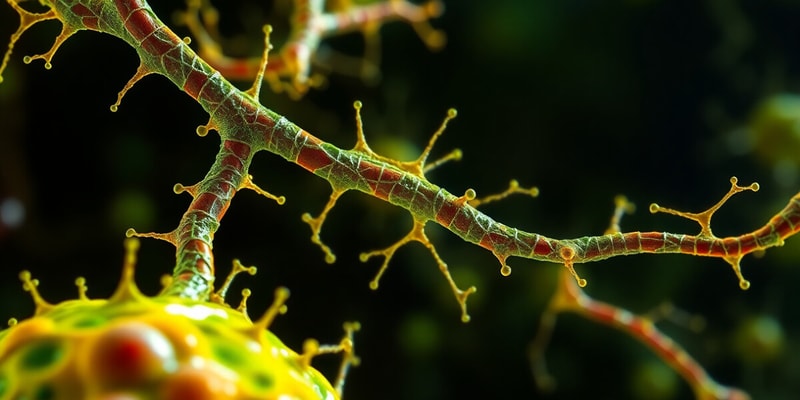Podcast Beta
Questions and Answers
What is the primary role of cell adhesion in multicellular organisms?
Which component is primarily involved in the initial attachment of bacterial cells?
What differentiates the extracellular matrix (ECM) in various tissues?
How do tissues form in a multicellular organism?
Signup and view all the answers
What is one significant challenge faced when moving from unicellular to multicellular forms?
Signup and view all the answers
Which of the following best describes the composition of a tissue?
Signup and view all the answers
What role do extracellular matrix components play in tissues?
Signup and view all the answers
Which statement about the extracellular matrix is incorrect?
Signup and view all the answers
What characteristic of the extracellular matrix (ECM) in bone and teeth allows it to withstand compression?
Signup and view all the answers
Which component of the ECM is primarily responsible for its elastic properties?
Signup and view all the answers
What is the main role of glycosaminoglycans (GAGs) within the ECM?
Signup and view all the answers
What is distinctive about hyaluronan compared to other glycosaminoglycans?
Signup and view all the answers
What percentage of the volume of the ECM do glycosaminoglycans (GAGs) typically comprise?
Signup and view all the answers
What is the primary function of the ECM in the cornea of the eye?
Signup and view all the answers
Which cells are responsible for secreting the macromolecules that form the extracellular matrix?
Signup and view all the answers
Which of the following GAGs is not sulfated?
Signup and view all the answers
What is a characteristic feature of a proteoglycan?
Signup and view all the answers
Which GAG is primarily associated with Aggrecan in the extracellular matrix?
Signup and view all the answers
What role does heparan sulphate proteoglycan play in cellular functions?
Signup and view all the answers
What is the typical size range of sugar residues in glycosaminoglycans (GAGs)?
Signup and view all the answers
What is the composition of collagen in the extracellular matrix?
Signup and view all the answers
What forms the core structure of collagen chains?
Signup and view all the answers
What stabilizes the triple helix structure of collagen?
Signup and view all the answers
What happens to procollagen after it is secreted into the extracellular space?
Signup and view all the answers
What is the consequence of a vitamin C deficiency on collagen synthesis?
Signup and view all the answers
Which type of collagen is the most common form found in skin, bones, and tendons?
Signup and view all the answers
How long do collagen fibrils typically last in the body?
Signup and view all the answers
Which property distinguishes type IX and XII collagen from type I and II?
Signup and view all the answers
What role does proline hydroxylase play in collagen synthesis?
Signup and view all the answers
What provides the extracellular matrix (ECM) with its elasticity?
Signup and view all the answers
What role does fibrillin play in elastin deposition?
Signup and view all the answers
Which glycosaminoglycan (GAG) is mentioned as part of the basal lamina?
Signup and view all the answers
What characterizes the structure of elastin?
Signup and view all the answers
How do type IV and type VII collagen contribute to the basal lamina?
Signup and view all the answers
What condition is caused by defects in the FIBRILLIN 1 gene?
Signup and view all the answers
What component is crucial for organizing and binding cells within the basal lamina?
Signup and view all the answers
Which of the following statements about the extracellular matrix (ECM) is incorrect?
Signup and view all the answers
Study Notes
Need for Cell Adhesion
- Unicellular organisms exist on their own
- Bacteria can be planktonic (free-floating) or sessile (attached)
- Multicellular organisms face challenges with cell adhesion, communication, and specialization
Cell Adhesion & Tissues
- A tissue is a group of similar cells and their ECM that perform a specific function.
- Organs are formed by multiple tissues working together.
- Cells can be linked through direct interaction or through the ECM.
- The ECM can be specialized for different tissues:
- Bone and teeth have a highly mineralized ECM for compression resistance.
- The cornea of the eye has a transparent ECM.
- Tendons have a highly elastic ECM.
- Blood plasma is a liquid form of ECM.
ECM Components
- Fibroblasts secrete ECM components in connective tissues
- Osteoblasts form bone, chondroblasts form cartilage
-
Main ECM components:
- Glycosaminoglycans (GAGs): acidic polysaccharide derivatives, form proteoglycans
- Fibrous proteins: including collagen family members
- Non-collagen glycoproteins: like fibronectin and laminin
- Others: such as elastin
Glycosaminoglycans (GAGs)
- Unbranched polymers of repeating disaccharide derivatives (amino sugars, sulfated acetylamino sugars, uronic acids)
- Acidic and negatively charged, attract positive ions (Na+), leading to gel formation
- Comprise 10% of ECM mass but 90% of volume
- Provide compressive strength (especially hyaluronan)
- Metabolically cheap bulking agent
Hyaluronan (GAG)
- Spun out from the cell membrane
- Enormous (10^7 kDa, much larger than other GAGs)
- Not sulfated
- Not covalently linked to protein ('stand alone')
- Often added to the ECM to hold open spaces for cell migration, then removed by hyaluronidase
Other GAGs
- Usually bound to proteoglycans
- 20-200 sugar residues long
-
Types:
- Chondroitin-4-sulphate
- Chondroitin-6-sulphate
- Dermatin sulphate
- Heparan sulphate
- Heparin
- Keratan sulphate
Proteoglycans
- Serine-rich proteins with hundreds of O-linked acidic, sulfated GAGs
- Link tetrasaccharide is assembled on a serine side chain, followed by GAG chain synthesis
-
Aggrecan (common proteoglycan):
- Core protein with ~100 chondroitin and 30 keratan chains
- Binds to hyaluronan (100:1) through adaptor proteins
- Forms large aggregates with hyaluronan (up to 5µm long)
Heparan Sulphate Proteoglycans
- Important role in cell growth
- Bind chemokines at inflammatory sites, prolonging white cell attraction
- Bind and block certain proteases
- Oligomerize FGF, promoting binding to its tyrosine-kinase receptor
Collagen
- Fibrous protein of three α-chains forming a triple helix
- Provides tensile strength to the ECM
- α-chains consist of GXY repeats:
- G: Glycine
- X: commonly proline
- Y: commonly hydroxyproline
- Hydrogen bonding between -OH groups of hydroxyproline stabilizes the triple helix
- Lysines can be hydroxylated and glycosylated
Collagen Synthesis
- Pro-α-chains synthesized on RER
- Assembly into procollagen
- Procollagen secreted into extracellular space
- Terminal propeptides cleaved to form 100nm long collagen chains
- Collagen molecules cross-linked to form fibrils (oxidative deamination of hydroxylysine and lysine)
- Fibrils self-assemble into fibers
- Fibrils are highly stable and last around 10 years
Collagen Defects and Scurvy
- Scurvy: weakened collagen tissues due to deficiency in vitamin C
- Vitamin C: cofactor for proline hydroxylase, which creates hydroxyproline
- Unhydroxylated collagen: destroyed before secretion, leading to weakened tissues
Collagen Types
- Type I: most common fibrillar form, found in skin, bones, and tendons
- Type II: similar tensile strength, found in cartilage
- Type IX and XII: fibril-associated, don't form fibers, more flexible
- Type IV and VII: form a mesh structure in the basal lamina
Elastin
- Provides elasticity to the ECM
- ~750 amino acids long, highly hydrophobic, rich in proline and glycine
- Non-glycosylated
- Alternating stretches of hydrophobic residues and alanine/lysine-rich α-helices
- Cross-linking via α-helical regions
- Hydrophobic domains are extensible due to loose random coil conformation
Fibrillin and Elastin Deposition
- Elastic fibers have an elastin core coated with microfibrils
- Microfibrils are made of glycoproteins like fibrillin
- Microfibrils act as a scaffold for elastin formation
- Marfan syndrome: defects in FIBRILLIN 1 gene, resulting in weak elastic tissues (e.g., Abraham Lincoln)
Basal Lamina
- Specialized ECM underlying epithelial cells
-
Roles:
- Structural support
- Determination of cell polarity
- Organization and binding of cells
- Barrier for certain cells
- Cell migration pathways
-
Components:
- GAGs: heparan sulphate
- Proteins: laminin, Type IV collagen, nidogen (entactin), perlecan
Lecture Summary
- Tissues are groups of similar cells and their ECM that perform a specific function.
- The ECM provides structure and support, and its composition varies between tissues.
- The basal lamina is a specialized ECM found beneath epithelial cells.
Studying That Suits You
Use AI to generate personalized quizzes and flashcards to suit your learning preferences.
Related Documents
Description
Explore the fascinating world of cell adhesion and the extracellular matrix (ECM) in this quiz. Understand the roles of tissues, the unique properties of various ECM components, and how cells collaborate to form complex structures in multicellular organisms.




